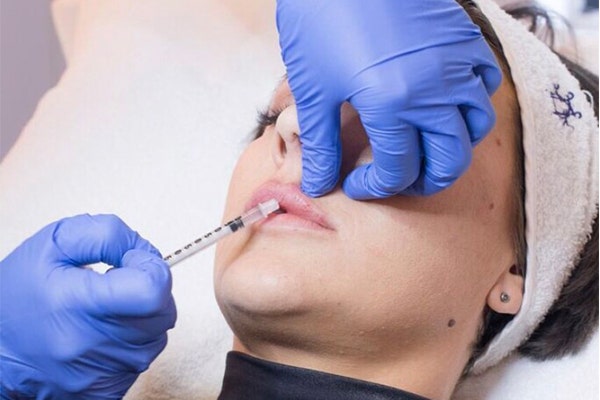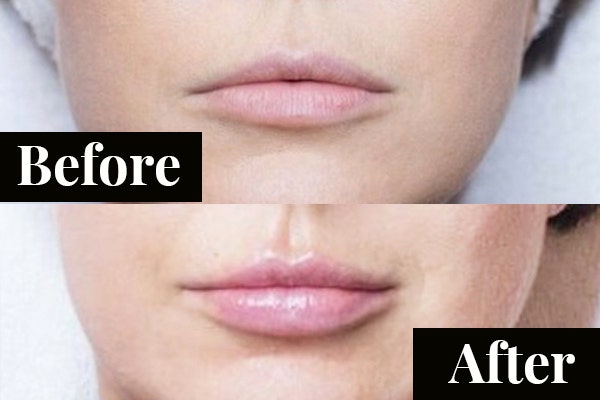9 Things To Know Before Getting Lip Fillers For The First Time
Know before you go!
 reshot
reshot By Nadia Bokody
As an editor of a women’s website, I make it pretty much my life mission to empower women to feel good about themselves. It’s for this reason I’ve refused to run a single weight loss article since I came on board at SHESAID, nearly three years ago. But as someone who’s personally dabbled in plastic surgery, I sometimes feel like a bit of a fraud preaching the whole “Be happy in your own skin” philosophy.
Then, of course, I remember I’m a grown woman who has the right to make my own decisions about what I do or don’t do with my body.
After all, the whole idea of the women’s body positivity movement isn’t to demonize women who choose to enhance themselves, but rather to reinforce the fact that autonomy over our bodies should be a prerequisite for everyone, regardless of what we do with it.
And so, rather than gloss over the fact I’ve had an ongoing love affair with the Botox needle and lash extensions — to name but a few of my cosmetic vices — since my mid 20s, I’ll generally come right out and admit my smooth skin and enviably long lashes are not the result of good genetics, or my commitment to a vegan diet (though I’m sure that helps).
Because so long as you’re doing it for the right reasons (read: yourself, not for anyone else’s approval or attention) then, why not own it? After all, cosmetic treatments are becoming more mainstream than ever, thanks largely to the Kylie Jenner Factor, and vast advancements in cosmetic science that have seen options like injectables become much more widely accessible, affordable and — for lack of a better word — less ‘plastic’ looking.
So it was with that in mind, I jumped at the chance to meet with one of the world’s foremost cosmetic nurse practitioners and injectable queens, Katherine Millar-Shannon, at her salon, Duquessa, in Sydney, Australia to guinea pig my pout for lip fillers. Here are nine surprising things I learned…
1. Research is king
Who you choose to administer your fillers can make or break your result, so when it comes to determining the right practitioner for your needs, you really can’t over-research, says Millar-Shannon.
“My entire ethos is about giving natural results. It is so important to find someone who also has this same goal. Ask the practitioner how much experience they have, how often they do the treatments; is it their main profession? Look at your practitioner — do they themselves appear age-appropriate, or overdone? Can you spot what they’ve had done? Does it look natural?”
Don’t be afraid to call a few clinics if you can’t find enough information on their websites, being proactive is key.
“My main advice is to ask lots of questions regarding the treatment and don’t just go to the cheapest person around,” reinforces Millar-Shannon.
2. Preparation starts one week out
“You should strictly abide by the pre-treatment instructions given by your practitioner. In the lead-up, drink plenty of fluids to remain hydrated before the procedure,” Millar-Shannon lets me know, seven days before I’m due to come in for my fillers.
“Avoid taking aspirin, ibuprofen, St. John’s Wort, and other medications that may cause or hasten bruising one week before and up to one week after procedure, unless medically indicated.”
3. Expect to pay the price
“Do not choose a practitioner based on price. Dermal fillers must be administered only by trained and licensed professionals,” Millar-Shannon warns. “Don’t undergo the procedure in a shopping centre or at home. Injections must be performed in a medical office or medical spa.”
For this reason, you should expect to pay a premium (between $650 to $800 per fluid ounce/milliliter), and steer clear of too-good-to-be-true sale offers to avoid a poor result.
4. Bruising is common, but preventable

Because the lip area is incredibly fragile, some subtle bruising is quite common following a lip filler treatment, however if you’re especially prone to turning black-and-blue, Millar-Shannon says you can reduce your chances of bruising with arnica tablets.
“Arnica might provide all-natural help for bruising and swelling, so several practitioners recommend their patients take them for a few days before and after their treatment. There aren’t any exceptional studies out there to back up its efficacy, but a lot of people swear by them, and unless you’re allergic, they certainly can’t hurt.”
5. There’s more than one type of filler
The two main types of fillers are temporary and semi-permanent. Because semi-permanent fillers are harder to correct, Millar-Shannon advises opting for a temporary filler for my first lip-plumping treatment.
“The most common temporary fillers in the market are hyaluronic acid-based. Hyaluronic acid is naturally present in the body, but is gradually lost with aging. Hyaluronic acid fillers add volume, resulting in a more natural look.”
This type of filler typically requires ‘topping up’ once every six months, whereas permanent fillers last an average of 12 to 18 months.
6. You can use leftover filler in the rest of your face
If you’re going for a more conservative result, like I did when I tried my hand at lip fillers for the first time, your nurse may not use up the entire vile of filler. However, because it can’t be reused on another patient, you’ll still have to pay for each full fluid ounce. So to make the most of any leftover, you can ask your practitioner to utilize it elsewhere on your face.
“Dermal fillers can also smooth out the facial creases on the forehead and eyebrow area, plump up the eyebrows and temporal region, smoothen under-eye hollows, enhance volume and define contours of the cheeks, chin and jawline and even soften the appearance of scars and other depressed defects,” says Millar-Shannon.
7. If you hate the results, they are reversible
Unlike Botox treatments, which you need to wait several months to wear off, fillers are fairly easily dissolved if for some reason you change your mind.
“Hyaluronidase treatment involves the injection of an enzyme solution under the skin to accelerate the natural breakdown of hyaluronic acid,” explains Millar-Shannon.
Phew, for that.
8. The treatment isn’t over when you leave the clinic
“Patients can get back to their usual activities immediately after their appointments, which typically last less than an hour,” reassures Millar-Shannon.
However, there are some mild limitations you should stick to in the 24 hours immediately after your treatment.
“Avoid bending over or touching the treatment area for the remainder of the day in order to allow the product to settle evenly. You may also wish to skip your daily workout for the same reason, and avoid consuming any blood-thinning products, such as aspirin or alcohol, for a couple of days afterward.”
9. People won’t be able to tell (unless you go over the top)

The first day after my treatment, my lips were noticeably swollen and very lightly bruised, but by the second day, I was getting compliments from women non-stop on how good my lipstick looked. It was actually the same one I’ve worn every day for the past year. Even my boyfriend stopped to take a second look at me when I got home from work, before tilting his head and adorably commenting, “Gosh you look beautiful!”. It seems people noticed I looked good, but not that I’d had anything ‘done’; which is a super common fear of first-time filler patients.
“The fear that you will look so dramatically different after the non-invasive procedure is likely just that: fear. In the capable hands of a qualified practitioner, the results of dermal fillers are meant to be moderate, making the patient look completely natural, just a little more refreshed,” insists Millar-Shannon.
But if you’re hell-bent on getting lips as big as Kylie Jenner and don’t heed your treatment nurse’s advice, there’s definitely a risk you’ll walk away looking disproportionate, which is why Millar-Shannon says she will personally turn away clients with unrealistic expectations.”
“It’s your practitioner’s job to tell you when enough is enough, and it’s also your job to try and listen.”
So, the final verdict; would I do it again? Absolutely.

